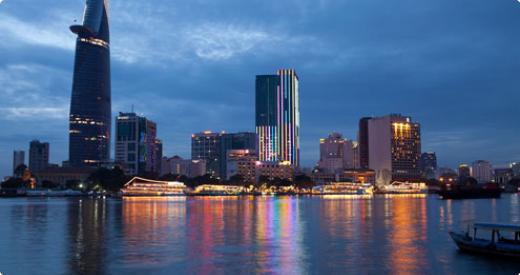
Population 6.2 million
Cuisine Southern Vietnamese, an amalgamation of influences from the colonial French and neighboring Southeast Asian countries such as China and Thailand
Signature Dishes Goi cuon (Vietnamese rice paper spring rolls wrapped around pork, prawn, herbs and rice vermicelli), banh mi (sliced baguette stuffed with pâté or sliced meat, Vietnamese pickled carrots and fresh herbs), pho bo (beef pho)
Wine Culture An exciting city for wine, with tremendous growth over the past ten years. While not a common beverage, wine is still part of the legacy that the French left behind and is a familiar sight in ambitious restaurants around the city.
Wine Duty Approximately 80%, which includes import and excise tax
The former French capital of Vietnam, Ho Chi Minh city, previously the Saigon immortalised by the famous Broadway musical, is the largest city in Vietnam. Situated in the south of the country, it reflects the different ethnic, cultural and political groups that have occupied it during its frenetic history- from the Cambodian Khmer Empire, to the French conquest in the 1860s. With the installment of the current Vietnamese Communist government, the policy of doi moi was introduced in 1986, allowing the people to run their own private businesses. Since then, Ho Chi Minh city has seen a steady transformations and economic breakthrough progresses, achieving a growth rate higher than the average rate of the entire country in 2010.
Vietnam is a country popularly described as two great rice baskets hung on either end of a carrying pole- in the middle is Central Vietnam, and on the ends, North and South Vietnam. Ho Chi Minh city in the south reflects more influence from neighboring countries like China, India and Thailand as well as the colonial touch of the French. This is keenly expressed in the cuisine, such the adaptation of mango sticky rice and Thai hotpot as popular party foods and banh mi , or the baguette sandwich as a commonly eaten street food.
The French have left their cultural landmark behind in Vietnam in the Notre Dame Cathedral. Previously a Vietnamese pagoda abandoned during wartime, the cathedral shows the beautiful moments of the French occupation of the city, featuring red bricks imported from Marseilles and coloured glass windows made in the Chartres province in France and even a statue of the Virgin Mary made in Rome. However, Ho Chi Minh city still echoes strongly with traditional Vietnamese culture. The Thien Hau Pagoda festival, in honour of the eponymous lady who risked her life for the people, is celebrated on the 23rd day of the 3rd lunar month. Every year, thousands of devotees travel to the pagoda in the city to pray for happiness, prosperity and fulfillment.
A jumble of Vietnamese street markets, French-style pavement cafés and new popular Western brand-name shops opening every month, Ho Chi Minh city offers a glimpse of Vietnam entering the modern 21st century under a successful Communist government. An exhilarating mixture of Southeast Asian cultures dipped into the rapid growth of the Asian economy, you never know what you might get with your next venture into this bubbling city of changes.









